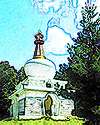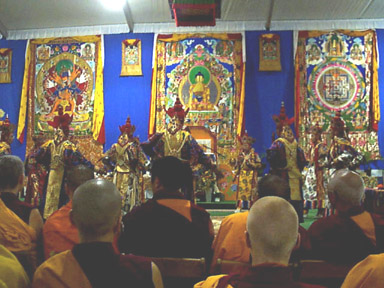GETTING TO KNOW US
-About the
TCC
-Thubten J. Norbu
-Our
mission
-Getting
Involved
-Gift
Shop
-Map
to TCC
-Pets
at the TCC
THE TCC GROUNDS
-Jangchub Chorten
-Kalachakra
Stupa
-Chamtse
Ling
-Retreat Cottages
-Grounds
stroll
EVENTS -PAST & FUTURE
-Event
Schedule
-Kalachakra
1999
-HHDL's
1996 Visit
-Medicine Buddha
Mandala
-Dorgyka Fire
Puja
-Event
Scrapbooks
TEACHINGS & SPEECHES
-Norbu's
1996 Speech to HHDL
-HHDL'S 1996 Teaching
-Aspirational
Bodichitta 1996
-Heart Sutra
3655 Snoddy Road
P.O. Box 2581
Bloomington, IN 47402
Fax: 812-335-9054
tcc@tibetancc.com


| page 1 | page 2 | page 3 | page 4 | page 5 |
- page 5 -
Days Seven through Eleven: The initiation After the teachings ended, only one day of offering dances and rituals separated the audience from the initiation itself. The sand mandala had been finished, and ceremoniously shrouded with curtains and banners and vases filled with foliage. Glass windows had been placed around its four sides. Hollywood stars -- notably Richard Gere and reportedly an incognito Harrison Ford -- had taken their seats alongside a rapidly growing number of Tibetans from all over the world. On the seventh day, after a final long morning of sadhana practice by the Lamas, dancers costumed to appear as the twelve offering goddesses emerged, and much of the seventh day was occupied by their performance. By the eighth day the tent was nearly full, and everyone was eager to delve into the rituals of the Kalachakra initiation itself.
For the remainder of the initiation, lengthy and complicated ritual procedures and both philosophical and practical instructions dominated the proceedings. Many tried to follow along in their program books -- or better yet, in Jeffrey Hopkins' "The Kalachakra Tantra: Rite of Initiation," a book which contains a full transcription of a previous initiation and was re-published in time for this occasion. Yet even with a detailed guide, the ritual is very complex and difficult to follow without extensive prior study. It is easy to see why someone would want to take the empowerment several times -- only a Buddha could fully perform such visualizations! The following sections contain brief notes for each of the remaining days as well as interesting comments by His Holiness and random observations.
Day Eight. This day began with a lengthy explanation of the Kalachakra's history and the circumstances which led up to this particular empowerment. With regard to the present occasion, His Holiness mentioned that there might be some danger that because of the popularity of the Kalachakra, many people may come to the empowerment because others are going, and their interest may thus be short-lived. But, nonetheless, He insisted that the ceremony is still beneficial because at the time it is held, everyone is in the spirit of an altruistic state of mind, which leads to powerful collective positive karma.
The ritual preparation of the students performed on the eighth day included adjusting the students' motivation, making requests to the Lama for the initiation, receiving vows and blessings, dropping the tooth stick and distributing blessed water, distributing kusha grass and protection cords, and a discussion of dreams. In addition, students were instructed in basic Vajrayana philosophy and the particularities of the Kalachakra path.
Vajrayana philosophy Q&A. . . .His Holiness explained it this way. What is innate nature? The mind of clear light. What is enlightenment? When one has perfect knowledge of one's own nature, or when the innate mind is perfectly knowing. Why do we have constant afflictions? Because of circumstances separable from the mind itself. What is the antidote? Nagarjuna says that it is the accumulation of merit and wisdom leading to the elimination of pollutants. Deity yoga (meditations based on deities like Kalachakra) utilizes a union of method and wisdom because the deities represent the method and the emptiness of deities is wisdom. In essence, in the visualizations we temporarily contrive a subject for meditation (i.e., a deity); we use the thought of emptiness and imagine it taking on a deity form. The deity is then essentially mind contemplating emptiness. Got it?
Financial issues . . .The issue of Kalachakra finances may have been on the minds of the audience members due to the cost of the ritual ($375 per person). It had certainly been an issue in the surrounding community, where an article was published disclosing expenditures in the local paper. His Holiness stated that, "We haven't gathered here for commercial purposes . . . . I haven't come here to sell the Dharma to you. My only motivation is as a Monk to be of benefit to others." He then requested that there be "clarity as to where the money raised is going to go." Following the initiation, His request was granted and the Tibetan Cultural Center announced that their approximated net profits had been $271,348.36 and that these profits would be split between the Tibetan Cultural Center and the special projects of The Dalai Lama in Dharamsala.
Tooth sticks and kusha grass . . .In a typical initiation, there are only twenty-five initiates at a time. Because of the sheer number of initiates at the Kalachakra (about 5,000 this time), it wasn't possible for each person to perform every initiating task. So, for example, when the instructions are that each person drop a tooth-stick (a Tibetan toothbrush) onto a mandala, a representative of the audience must do it. The first tooth-stick dropping was performed by Taktser Rinpoche (Thupten Jigme Norbu), the main sponsor of the event. The deity to which it pointed indicated that peace was a main inclination of this audience. To this, His Holiness responded, "Regardless of whether there is going to be world peace or not, what is important is that there is peace within you . . . . you should not point fingers outside but look inside yourself."
Each initiate did receive his or her own kusha grass (for stimulating dreams) and red protection cord, as well as water for rinsing the mouth. The ceremony only required modification when it was completely impractical for each individual to perform a particular task.
Day Nine. On this day, His Holiness went over the unique attributes of the Kalachakra path and the qualifications required of a Lama who is to confer it -- including several retreats. During the rituals of the day, the disciples offered the Kalachakra mandala, put on blindfolds (actual strips of red cloth) in order to remove them at the moment of visualizing the mandala, received flowers to offer deities, made requests to the Guru, cultivated proper motivation, took the vows, and generated all-encompassing yoga. At the end of the day, they entered the mandala imaginatively, took pledges and facilitated the descent of the wisdom beings. The initiations themselves would be granted the next day.
Complicated Kalachakra . . . .Before beginning the ritual ceremony, a long list of the holders of the Kalachakra lineage and the sadhana lineage was read. At the name of the eighth Dalai Lama His Holiness stopped, laughing, and said that in fact, His teacher Ling Rinpoche had told Him that no one ever heard of the eighth Dalai Lama conferring the Kalachakra. "This text [containing the lineage lists] was probably printed during the lifetime of The eighth Dalai Lama!" A bit of "irreverence" every now and then lent a welcome break to the heavy concentration of most of the ritual proceedings, as the audience struggled to soak up the dense philosophy and imagine such things as a full mandala with 722 deities.
The complexity of the Kalachakra may well have proved a main obstacle to its transmission over the years, although obviously it has been well preserved nevertheless. A paradox remains to this day between this difficulty and the popular appeal of the Kalachakra. During the course of the ninth day, His Holiness said that a Lama was once reputed to have said, "when I encounter other tantras, I feel that they are familiar, but when I encounter the Kalachakra my intelligence feels reduced to that of a sheep!" The Dalai Lama added that were He to try to write a commentary such as the ones that have been written in the past, He too would be reduced to a sheep. In general, by the end of the day we could all conclude that we felt about as apt as sheep with the Kalachakra. But, thankfully, the only requirement of the students cited that day was that they be full of admiration for and interest in the Kalachakra practices, not that they be able to comprehend it.
Day Ten. This day was packed with the granting of the seven initiations of childhood, the higher initiations and the vajra master initiation. The basic procedure for each of the initiations is that the disciples first imagine arriving at a particular gate of the Kalachakra mandala, which is a great palace. They sit at the initiation seat at the gate and request the particular initiation, after which particular parts of them are generated into the deity Kalachakra, or some other deity, usually in union with a consort. So, for example, in the Vajra and Bell initiation, the right and left channels of the body are transformed into Vajrasattva and his consort, which purifies them and readies them for eventual permanent transformation. An understanding of the Vajrayana view of the workings of the mind and body together are needed to fully understand the transformations intended. After all of these initiations are complete (which is a long day indeed!), the disciples are said to have cleared away defilements, and are ready to cultivate the stage of generation along the Kalachakra path. The Guru yoga meditation practice, one version of which is included in the Kalachakra handbook, is thus open to them. The ultimate goal of all of these proceedings is to eventually become Kalachakra Himself, and therefore to achieve enlightenment. Is everyone initiated? What next?
Everyone who sits through the initiation isn't necessarily initiated. Alexander Berzin best sums up a common modern interpretation in "Taking the Kalachakra Initiation": "The steps of the initiation are extremely intricate and, without familiarity, the visualizations can be quite perplexing. But if, as a proper vessel, we take the vows with full sincerity and at least feel, with strong faith, that all the visualizations are actually occurring, we can be confident that we are receiving the empowerment. With this basis secured, the next step is seeking further instruction and then trying, as sincerely as possible, to travel the full path to enlightenment as presented in the Kalachakra Tantra." The initiates have a copy of the six-session yoga of Kalachakra (both short and long versions) in their booklets, and thus are fully armed and ready to go.
Day Eleven. The final day was filled with closing ceremonies, including a long-life prayer for the public and for His Holiness The Dalai Lama. A few members of the audience then performed a song that they had prepared, "Dream of Peace" by Simon and Garfunkel. For the next few hours, everyone said their good-byes, performed last-minute shopping in the Kalachakra sales booths and lined up to view the sand mandala before its ceremonial dismantling in the nearest body of water.
Were they satisfied? Enlightened? Feeling a bit more peaceful? For answers to these questions and more, look for the Kalachakra survey results, to be posted soon on this site.
| page 1 | page 2 | page 3 | page 4 | page 5 |
| back to kalachakra 1999 index | back to main sitemap |
